Updated 03.03.2017
How many of you like me have been put off buying Orchids at the Garden Centers because of the cost and the worry of the plant dying almost as soon as you get home?The majority of the orchid plants we have are Phalaenopsis, they are easy to care for and bloom several times a year. all of the plants in this photo are of the Phalaenopsis variety which as can be seen come in a large variety of colour and variations. .
Well we took the ball by the horns when our favorite store named by 'Which' as retailer of the year 2008 'Lidle' they had orchids for sale on what are termed 'specials day' where they sell every conceivable things from screw drivers to computers, not all on the same day of course but when advertised in the brochure or on their web page the previous week.
If you use the link above you will see what I mean.
One of things I love about the Orchids is the variation in the flowers every plant is in some way different.
How many of you for instance can boast of such a beautiful plant in your bathroom, the last place you would expect to find the plant, and yet this plant has been in bloom for months and I'm not exaggerating, and now that this set of ten blooms is just going past their best another spike stands in the back ground waiting to take over.
As I have mention liquid feed, we use the type shown, BUT do follow the instructions or you will not get the results you want; over feed and you will damage the plant so take care. Also when buying ,there are feeds for growth and feed for flowering, so make sure you purchase the one you intended buying.
Are you Hooked?
Then how are you going to best select an orchid? Well don't go for the plant with the most flowers. Choose a plant that has spikes of flower buds which in turn will acclimatise to your residence before coming into bloom.
Make sure you can distinguish the difference between orchid roots R and flower spikes S This plant has masses of roots not just in the pot, but also aerial roots they twist and bend searching for some damp mossy crevice to lock onto, as they would in their native environment. it has not been re-potted and is as purchased some 12 months ago, most of the orchids we have purchased have been in these clear translucent pots which is useful, as you can keep an on the root system. So if your not sure which is which ask to see the person in charge of the orchid section, and seek their advise. Having made and got your purchase home, hopefully safe and sound?
Look to see how moist the planting medium is before even considering watering your plant, it goes with out saying that a plant with flowers requires more water than one without , but as my grandson Louie would say "water it, don't drown it" if you have it in a decorative plant holder then check the following day after watering that the plant is not standing in water, tip any surplus away.
Feed from the top avoid direct contact with the roots, use tap water at normal temperature. small amounts of water are better than one large one. Water more in the summer than in the winter but if you have central heating keep an eye on the planting medium and water as required.
Potting /re-potting
Do not stand your orchid in direct sunlight, we keep our on a north facing widow sill which is well lit during daylight hours and only get a very small amount of sun in the early mornings, as you can see they are all doing well.
Encouraging further flowering
In all cases where the orchid has stems, keep these well supported using thin canes or dowel rod and the special clips 2 that you will receive with you flowering orchid.
When the whole stem dies back cut off with sharp scissors, avoid watering direct onto the plant growth as this will encourage disease.
In the case of the white orchid it has ten flowers , and another main spike on which there are a further 10 healthy buds.
Flowers of the future.
And this beautiful dark pink (Below) is my latest purchase and at £4.99 what a bargain, loads of buds twin spike and in good sound condition,
One of the benefits to purchasing a plant in bud is that the plant gets a chance to acclimatise to it's new home before bursting into full flower.
5/6/08 Hopefully I'll remember this time as the plant has just started sending up another large shoot. 'Watch this space!
This plant has doubled in size over the last 3 months and promises another show of flowers a bit later in the year.
Then there was this little plant which I purchased 3 years ago, and although it was in bloom when I purchased it with masses of flowers when they died it never bloomed again. Very disappointed at this because it marked very special time in my life, I contacted the garden centre where it was purchased, they had very little knowledge of the plant I was talking about even though I had it with me. No help there.
I later visited a garden Centre on the A24 Worthing-Horsham Road West Sussex Old Barn Nurseries and they came up trumps with all the information on this plant .
It needed to be outside certainly for the summer months and will with stand cold weather, almost 10 months outside, not neglected but certainly not pampered, and it survived, albeit was standing on a gravel bed so that it did not become water logged.
In January 2008 at the promise of a really cold spell I brought it indoors, and placed in one of our cooler rooms, to my utter surprise and joy it suddenly, within days started to sending up flower shoots,
Mind you one tip if you are taking photographs of you flowers try and take them using natural light, this photograph taken with a flash displays a totally different colour for the same flower and would mislead you if you were looking for the same plant, the dark flower on the left is the one taken with the flash.!
I'm also pleased to say that the Dendrobium Infundibulum is also in bloom with four beautiful flowers on a single stem, this plant is also keep in the coolest of our rooms .
And if by chance you are into 'crafting' take photographs of you orchid blooms for (Greetings card making etc)use them to make up beautiful cards, this one in 'decoupage', what more pleasure could you want from a living plant.
Happy Hunting and select the right plant, start with the varieties shown on this page which are the easier ones to deal with and grow then go on to the more difficult varieties if you really want a challenge.
I now it's only the 11th of February 2008 but in our bungalow it really is spring. and the sun shining through the flowers of the yellow orchid shows great promise for the year ahead.
and the north facing window is a real picture with masses of blooms from the various plants intermingling with one another .
What I really like about the orchids is the variation in colour and size, here are just two such examples.
This orchid joins the rest on my wife's birthday in July one spike of flowers , a very attractive plant the label says Dendrobium Oneidium, Cambria Zygopetalum Cattley, doesn't mean much to me, the point is a lovely orchid unusual colour and
Yes the buds opened but I lost one spike of flowers because I failed to notice that the stem of one spike was being bent while growing with the result that the weight of flowers damaged the stem to the degree that the flowers couldn't survive, Where you have orchids of this type ensure the spikes are well supported with a cane or dowel rid or like me you will loose the beauty of the flowers. June 8th 2008
Mean while the other plants display their full beauty.
08/07/08. We have just returned from to weeks holiday to be greeted by this amazing display of blooms 13 identical flowers and 1 bud, what a greeting! Would make a beautiful ready made bouquet, although the wedding might have to be at the plants discretion!
July 2008 This orchids has 24 flowers and buds on three spikes , what a beauty and it's in the bathroom where it appears to love the cool temperature and damp conditions created by the bath.
December 2008 5 months later and this plant is still in bloom, I know of no other plant species that will give such pleasure and value for money.
April 2009 and still the plant blooms, the flowers just last & last
Because of the damp cool temperatures of the bathroom some of the older flowers have developed spots, most plants would just drop the flower not the Orchid it has simply continued to bloom and the flowers are still in away beautiful.
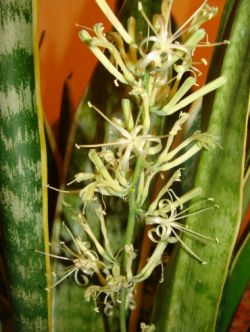
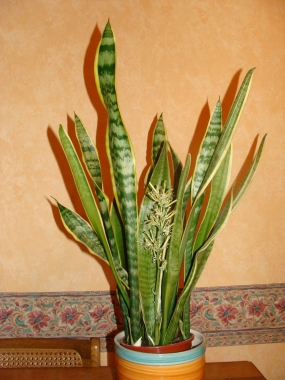 Your right, it's not an orchid!
Your right, it's not an orchid! It's the plant known as "Mother in laws tongue" (Sansevieria trifasciata laurentii) so why is it here ? Well we have never seen this plant in bloom before and suddenly after three years it's decided to bloom. Pretty in it's own way, with delicate almost translucent flowers, long stamen and masses of nectar droplets.
I suspect that in it's natural habitat it would attract the moths, because it has a very nice smell in the evenings
25 blooms and two buds what a string of flowers
I posted this photo in July 08 and believe me this plant is still in bloom, a number of the flowers do have green spots on them caused by the over damp conditions along with the cooler temperatures but still they bloom.
And in July 2009 its still producing I think even larger blooms and is magnificent.
The Orchids never fail to amaze me at their shear beauty four flowers again on this plant, with three buds yet to break and they are if they have been cloned. Nature can do what man takes years replicate, although of course I accept that man is responsible for so many orchids being available in recent years.
One could be forgive for believing that these 2 photographs were simply flipped on the pc. But no they are four different blooms, study them closely and you will see the difference!
Just as I predicted this plant is going to have a real show of flowers having four spikes of flowers buds forming on three of the large stems, this is not my favourite plant but it's going to have a show of flowers that I estimate will be just about Christmas time 2008 I will post another photograph when it's in bloom.
2008. 'Merry Christmas everybody.
24/12/08 'Just made it for Christmas' with loads more buds to open in the coming weeks and into 2009 Happy New year
Well where has 2009 gone? Here we are November the 4th nearly having reached another Christmas and not a single addition to the page. However we have not been without blooms on at least 3 of the orchids plants at any one time throughout the year
However this year this orchid has decided to bloom a little earlier

And not to be outdone this Dendrobium, more like a leek plant than an orchid when not in bloom has produced the most interesting root growth as well as sent up another shoot and is now about to bloom on 3 of the spikes.
Long term care of your Orchids
As some of you who have visited this page before will be aware a large number of our orchids shown on this page are now several years old, in some case 5-6 years old.
They have continued to broom and grow with little attention apart from feeding and watering, however most of them have now reached a stage where they have become untidy with surface roots growing in every direction
In there wild state this of course would be no problem but in the house they need attention if they are going to remain presentable.
I've not read anywhere how this problem can be overcome and so realising that we would either have to dispose of the plants or take drastic action to tidy them up I decided to re-pot one as an experiment and see how the plant would react.
I took the oldest of the plants and removed it from the pot shook the roots clean of the compost and it's true to say that the clump of roots was as large as the remaining plant
I then sorted out the roots and cut off the majority leaving just the healthy ones growing nearest to the leaves, this then allowed me to replace and lower it back into the original pot which of course I cleaned first.
The compost which was made up of all of the original compost plus some new to make up the amount required, having ensured the compost was in contact with all the roots with no spaces in the pot I then submerged the pot in water ensuring the compost was not floated out of the pot and became soaked which only took a few minutes, I then removed the pot from the water and allowed it to fully drain.
Quite expecting to plant to die I placed it back with the others and monitored it over the next few weeks.
To my surprise I didn't die or indeed show any signs of stress and an even bigger surprise when it started sending up new leaf and after only a few more weeks a flower spike.
It was also clear through the clear flower pot that new roots were also forming those that developed near the surface of the growing media we encouraged to go down into the compost. I did this using bronze wire which can be purchased for training Bonsai trees I simply made up staples and gently keyed the growing root to the surface of the growing media rather than letting the plant form aerial roots.
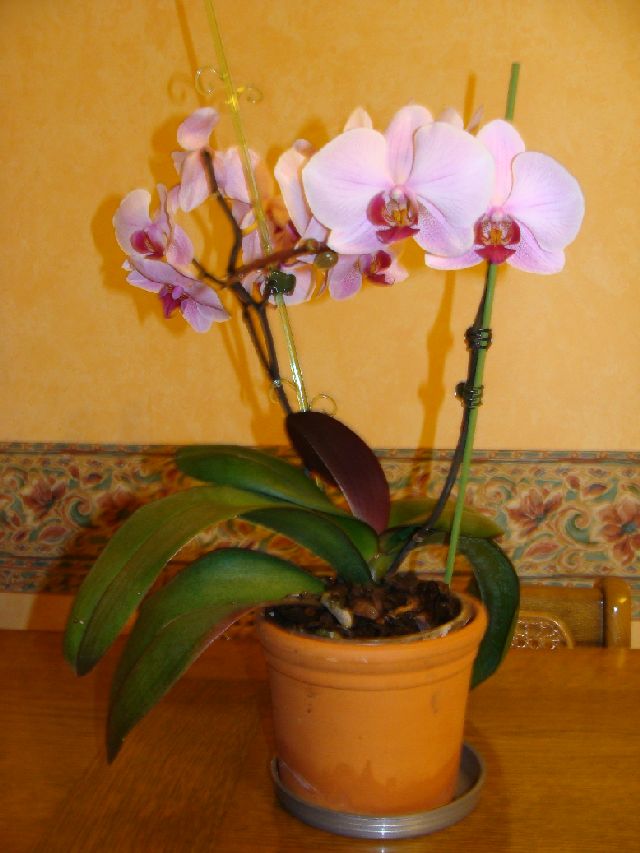
This plant is now as if a new plant, it's just had a further two lovely spikes of flowers which has encouraged me to take the same action with a number of the other plants we have, all now being some years old.
To me it seems a drastic action and I really didn't expect the plants to survive but to date we have not lost one plant to the compost heap.
The plant below is an example of what the plants look like before the re-potting the other two are plants which have been re-potted and as you can see after only about a month six weeks have grown new leaves and both are sending up vigorous flower spikes .
The plant below is an example of what the plants look like before the re-potting the other two are plants which have been re-potted and as you can see after only about a month six weeks have grown new leaves and both are sending up vigorous flower spikes .

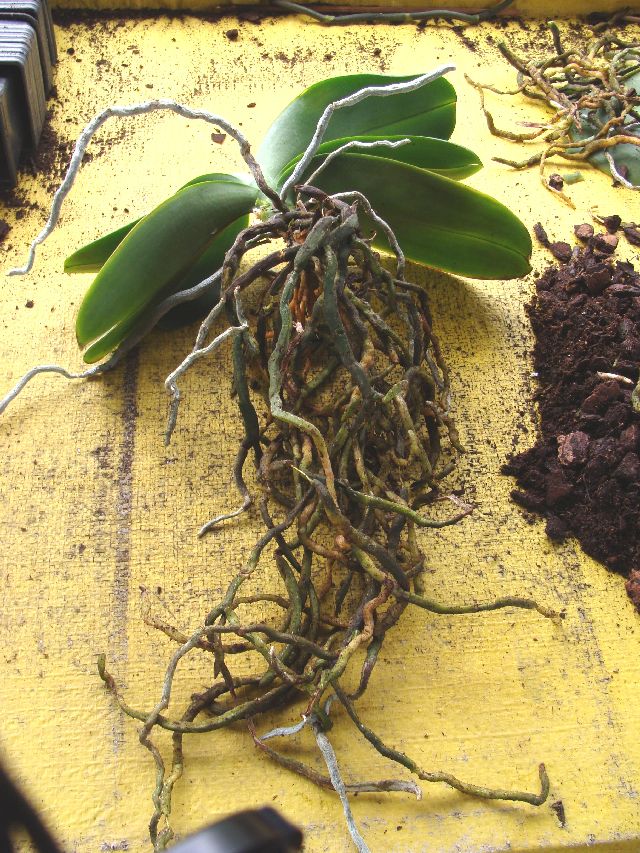
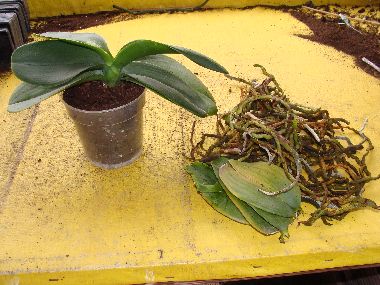
These three photos show the stages of re-potting,
If possible water the plant two to three days before undertaking the re-potting.
First removed the plant carefully from its pot
Then all the roots which will be found cramped into the pot are teased out with the broken and weak being snipped off with scissors, approx one 1/4 to 1/3 of the roots are retained, in this case four of the lower leaves were also removed by carefully easing them away from the plant stem.
The best roots are preserved and the plant placed back into same pot which can be washed or replaced at this point. (do not increase the pot size)
Re-pot the plant ensuring the remaining roots are carefully placed so as not to break them.
The compost removed along with new orchid compost is then placed into the pot onto of the roots and the pot tapped on the working surface to ensure the compost filters through and surrounds the roots.
All the plants treated in this way are doing well, so all will treated in this was as they stop flowering.
However if you follow this practise I would suggest you stagger the process or you will be without blooms on all your Orchid plants at the same time.
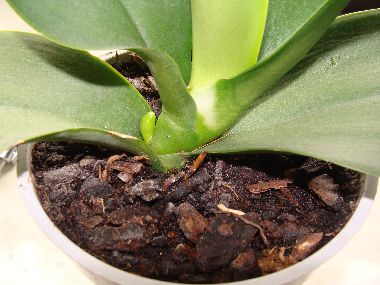
In the case of this plant is was re-potted approx 6 weeks ago and as can be seen is already sending up a spike.
You should not attempt to undertake this drastic procedure to plants on which flowering spikes are still present, this would place far too much stress on the plant and it may well die.
Certainly it has extended the life of our plants which will enable us to enjoy their beauty for years to come.
Or if like us you have accumulated a large number then the revitalised plants are now tidy enough and nice enough to give away to your friends as presents.
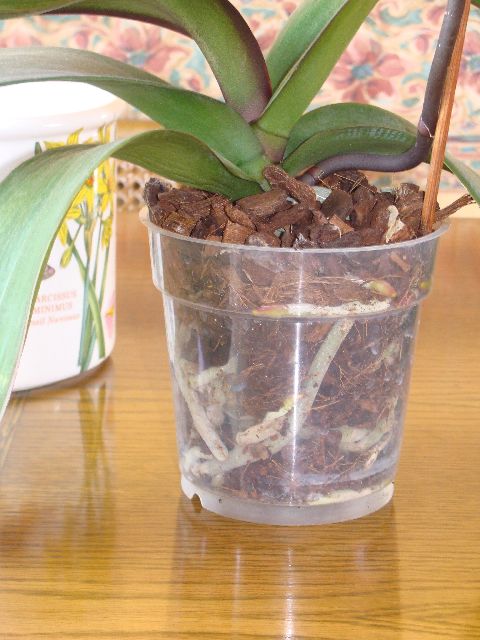
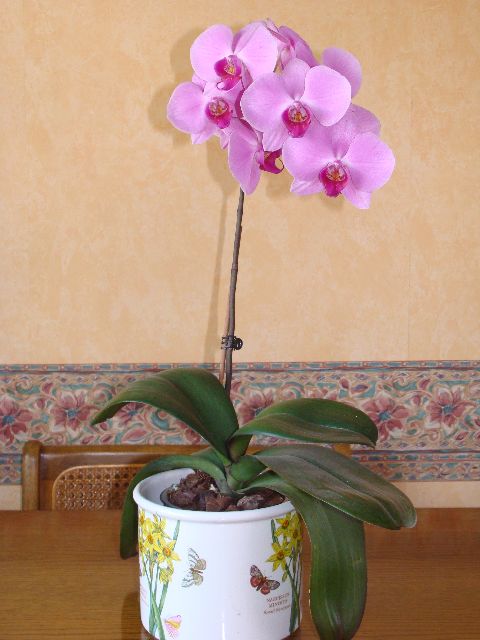
This plant is typical of the way all the plants have responded with vigorous root growth and strong spikes of flowers.
This is our latest acquisition, a 'Zygopetalum'(Lady bird Orchid) although not like the lady birds insects in our garden . But do not be fooled into thinking it is hardy, I photographed it with other shrubs and plants into garden to display it's true beauty. Hopefully it will be easier to maintain than the Dendrobium (Emma)which sent up spikes of flowers but only ever produced a couple of blooms the rest of the buds dropping off.
I am pleased to say that this plant is easy to grow and blooms without problem , it has a very nice scent in the late evenings and the flowers last for a good period of time.
Also because this plant outgrew it pot we now have two plants and both bloom without problems.

.
Those of you who have visited this page before will be aware that I have re-potted all of them over the last fourteen months, did it do any harm, no they are now much tidier some of the plants being 5 years plus old and as you can see from this display they are all back in bloom and going strong
'Blooming Beautiful'
Lofty
 Well it is a very long time since I added any material to this page , but I can assure everybody that the orchids are still doing fine and this one in our bathroom is now some weeks in bloom with 19 flowers, along with the matching pot it brightens up what is otherwise just a bathroom.
Well it is a very long time since I added any material to this page , but I can assure everybody that the orchids are still doing fine and this one in our bathroom is now some weeks in bloom with 19 flowers, along with the matching pot it brightens up what is otherwise just a bathroom.June 6th 2013
Where does the time go, it is ages since I added any information or photographs to this page, never mind I will make up for it now by added photos of our new additions.
This plant has done wonders I have split it several times and given the plants to friends.
The original plant blooms two sometimes three times a year and having finished blooming only about one month ago has now got a spike with 9 healthy flower buds, I would say one of the easiest plants to grow and look after. large flowers that last and last.
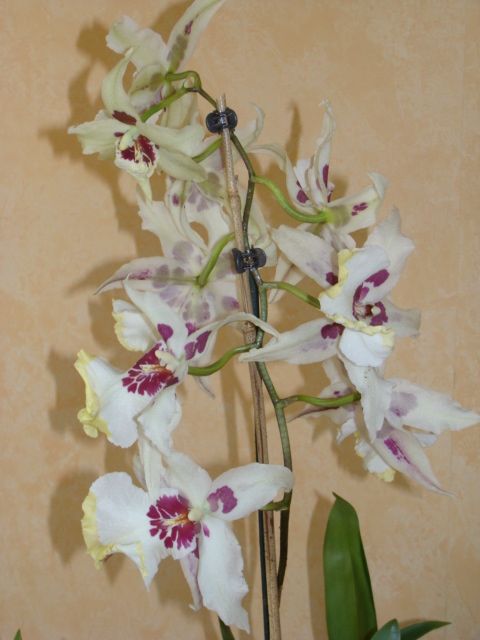
Six weeks later and it is in full bloom
and because the plant has got so large I have had to divide it into three , this is the second time since I bought it that I have had to split the plant
We love orchids but we do not want them taking over.
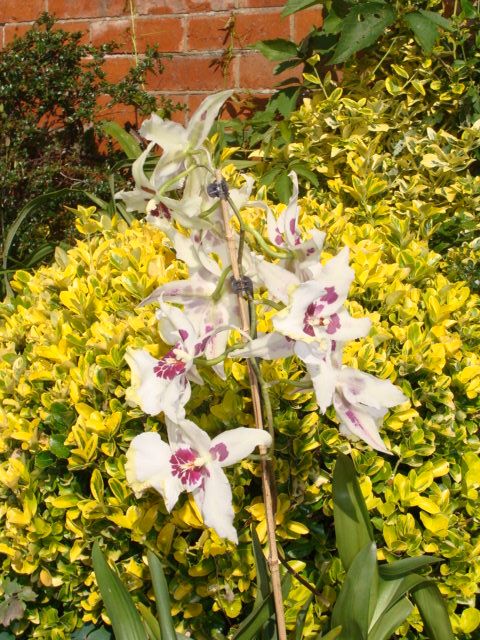
What a pity we do not get warm winters , they would do well and look great in the garden backed by the shrubs.
This plant on the right, purchased a couple of years back has done well and blooms a couple of times a year, it is a bit untidy but the blooms are very pretty and are perfumed in the evenings.
Living on the bathroom window sill it does well and the root system indicates that it is happy with the conditions.
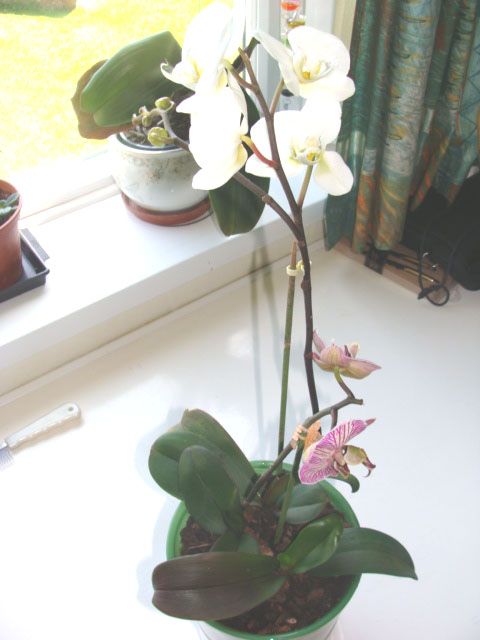
Some of our orchids are now very old, 10-12 years old , although we have not destroyed any, the now smaller plants have been put into one pot.
In this case I have put three small plants into the same pot and they are doing very well .
We have had two of the plants in bloom at the same time but not yet the three .
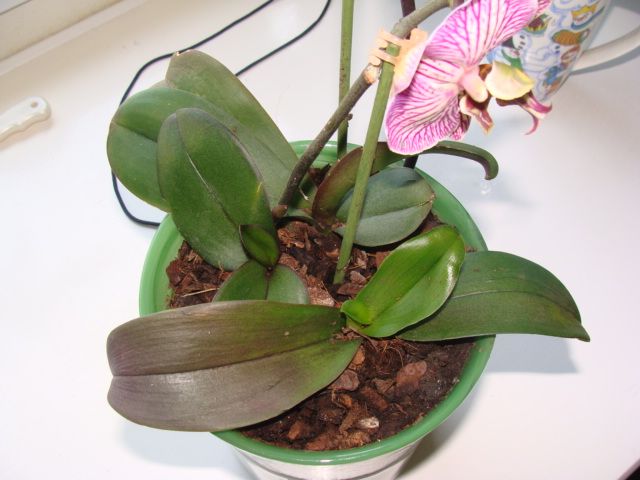
As can be seen there are new leaves forming and the plants look very healthy.
I feel sure that the last six months of cold weather has not helped the orchids , we have had a job to keep the bungalow and ourselves warm, Keeping it at a minimum of 18c has proved quite a challenge and I feel sure that even the orchids have suffered they being on the window sills in close proximity to the glass, albeit double glazed, they are all starting to look better now.
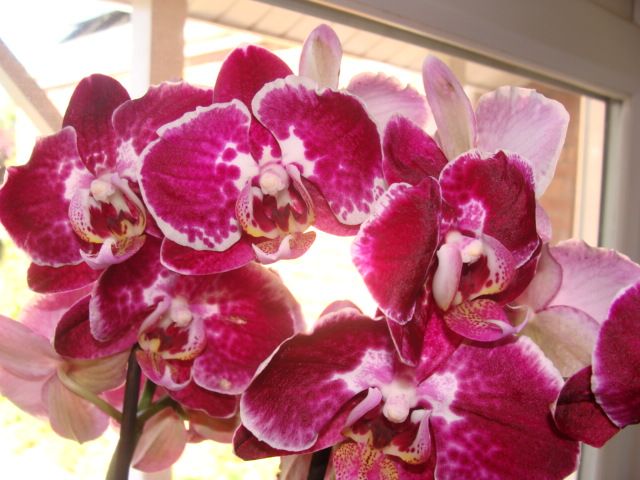
We have in the last few months invested in several new plants and have managed to get good plants of various colours.
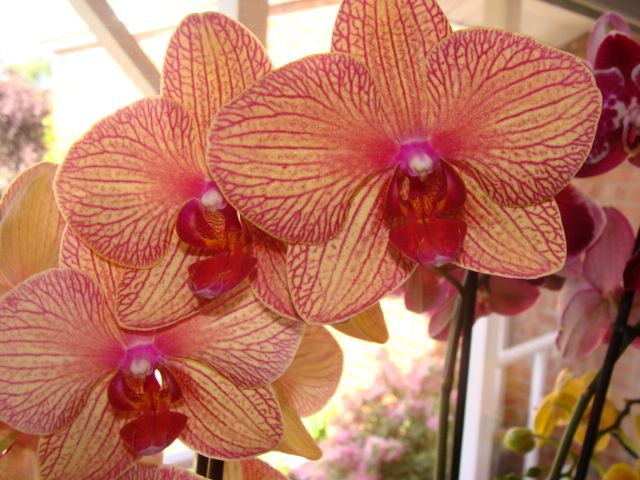
All of the plants purchased were twine spike and we made sure we bought healthy plants that were housed in a building (Garden Centre) which was of an even temperature so that they would not drop the existing flower buds when being moved to our property.
In all cases the buds have continued growing and have now come into full bloom.
A severe change of temperature will cause the buds to go yellow and they will drop before coming into bloom.

We chose this plant because it is of the most delicate soft pink. delicate in appearance.
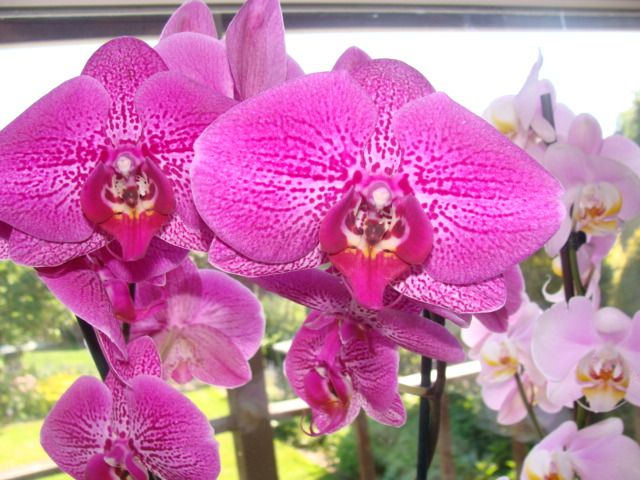
Where as this one is a dark mottled pink

To try a describe the beauty of these plants is impossible, each one being different in colour and contrasting with the other orchids.
Not all of our orchids are in this photo, but I feel sure you will agree they are beautiful, feed and watered they go on and on and in my experience are the best value plant available.
No other flowering indoor plant blooms for so long as the orchid.
Since visiting keukenhof (NL)back in April 2013 our enthusiasm has been rejuvenated and we are now looking for the less common colours of orchid, which at present is no problem because most of the super markets are selling them very cheap indeed, £5.00 for a flowering plant that will last months and re-bloom if looked after seems to me a bargain.
In Mid November of 2013 we bought a Cymbidium orchid which had four spikes in tight bub hoping that it would turn out to be a green flower, after a week or so the first bud opened and to our joy it was a green. ( Cymbidium Fort George 'Lewis')
We bought it in tight bud to allow it to acclimatise to the conditions of our bungalow, as a severe change in temperature can cause the buds to drop off.
Within a Month all of the flower buds had opened and the plant really is beautiful, it remained in flower for about seven weeks then the flowers died with no chance of further flowers until late 2014 .
I removed the dead spikes of flowers and towards then end of May stood the plant outside in a shady flower boarder we had quite a bit of rain throughout the summer and the pot in was in allowed free draining of excess water, I did also water it during a couple of dry spells during the summer months.
In mid October I moved the plant from the boarder to the open North facing balcony and giving it a feed using the 'Vitax' growth liquid feed, finally bringing it in doors about the end of October as the nights were getting colder. Inspection of the plant only a week or so later revealed that it was sending up three spikes which continued to grow throughout November and December.
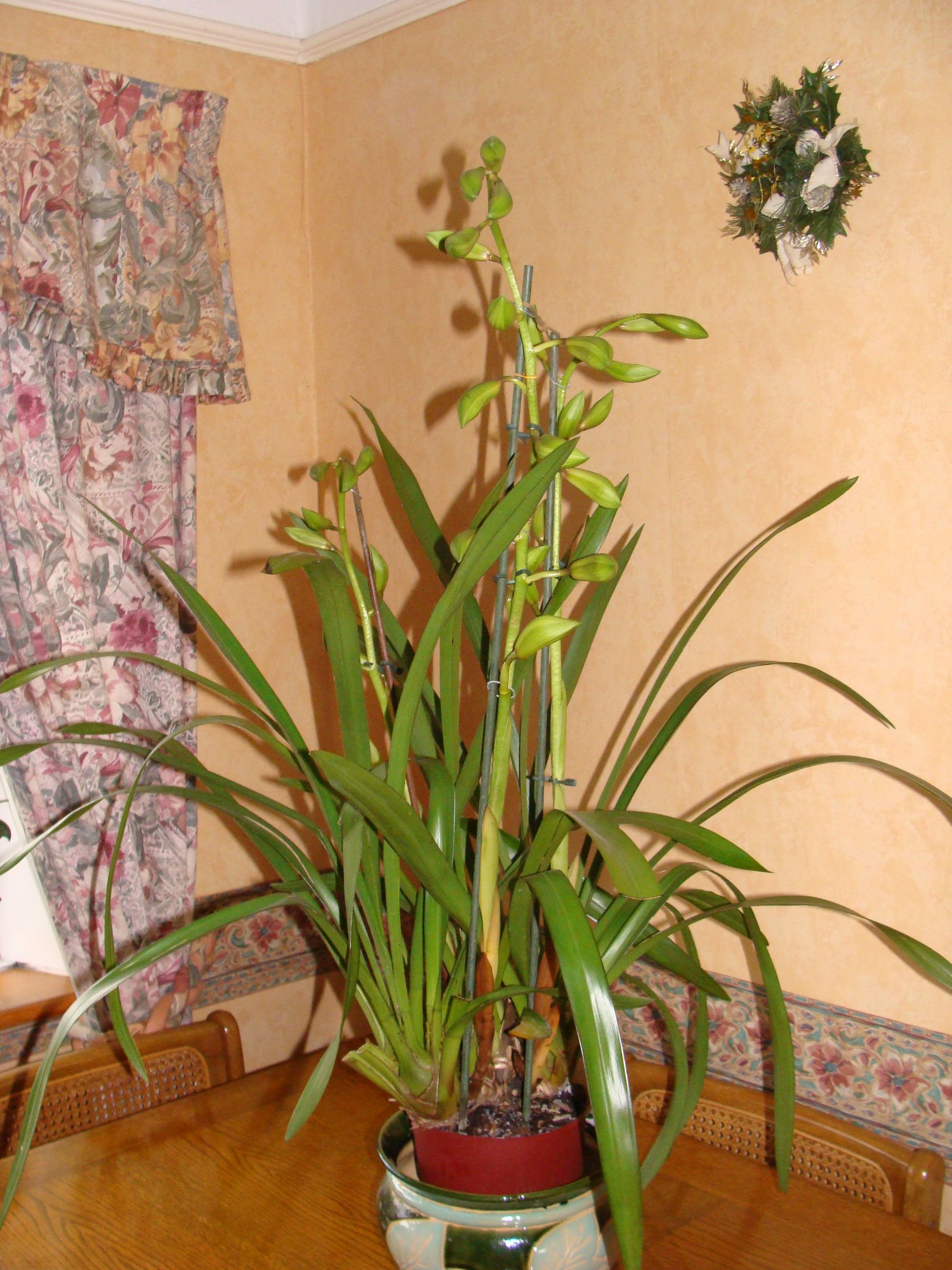
 We have now reached the 2nd of January 2015 and the first flower on the largest spike is just opening, on the three spikes there are a total of 32 flower buds all of which at this stage look healthy.
We have now reached the 2nd of January 2015 and the first flower on the largest spike is just opening, on the three spikes there are a total of 32 flower buds all of which at this stage look healthy.If you are considering getting a Cymbidium orchid beware they grow very large this one is in a nine inch pot and at present stands 2 feet 10 inches tall to the top of the spikes, also it will almost certainly need re-potting into a larger pot this year when it has finished blooming, albeit only needs moving to a slightly larger pot say 10 inch as these orchids bloom best when the roots are restricted, we are before that looking forward to approx 6 weeks when the plant will be in bloom.
Bearing in mind what I said about size, if you want to grow orchids but are not at home to look after them in the summer then because these stand outside during the summer months are ideal.
If you want orchids in bloom all year round and have the time to look after them then the phalaenopsis is the best buy but of course remain indoors though tout the year.
Compared with Phalaenopsis Orchid the flowers do not last anywhere as long although while in bloom the plant was a real picture.
Last Year 2014 the plant was in full bloom for about 6-7 weeks as so was still good value. This plant likes to be cramped in the pot so I will not be splitting this plant.
African Violets
I do grow African violets from leaf cuttings and when in bloom are very pretty, but they are not easy to look after , too much water and the rot off too little water and the flop. But are cheap to purchase, and are very nice when in bloom, they also come in various colours although all these are violet Blue.
The African Violet, in bloom, along with one of the young plants that was grown from a leaf cutting over the winter period.
The Mother plant is now several years old but still blooms readily.
All of these plants have been grown from leaf cuttings.
 If you have a healthy African Violet, and would like another, select a healthy leaf from the mother plant and break it off with a long steam.
If you have a healthy African Violet, and would like another, select a healthy leaf from the mother plant and break it off with a long steam.Simply place it is a small glass tube of water, leave and watch.
Allow this to continue until there are multiple roots projecting from the bottom of the leaf stalk
Then find a suitable (3-4" pot) pot and plant the leaf in moist potting compost.
, Make a hole large enough for the roots and lightly cover the roots and part stem.
Keep the compost moist but not wet
The minute new leaf in this photo is only two days old and is about the size of a match stick head, do not be in a rush to cut of the mother leaf it will do no harm and can be cut off in a few weeks time.
When the new leaves are little finger, nail size cut off the main leaf and discard, treat your new plant as you would any other but do not over water or the plant will rot off, I wait until the leaves are a little floppy, and then water.
If when you touch the leaves they are still stiff and full of life then just leave.
They do not want a lot of water while small.
Costs nothing and it is interesting watching how a new plant can be grown from just one leaf.
You may find that there is more than one plant from your single leaf, all of these plants which are still small have come from a single leaf cutting.
Why not give it a try!
Good luck.
Lofty
They say the proof of the pudding is in the eating, well in this case the proof is when the plants come into bloom and as you can see they did all make it, cost nothing just a few used pots care and water and you will be rewarded by as many plants as you want to grow.
So what of the Orchids, They are all doing fine.
I have been asked two questions:-
Q. How often and how to water,
A. Watering as well as feeding is undertaken about every two to three weeks in the summer months and every of 6 to 8 weeks in the winter this is done by placing the orchid pot in a larger container of water and as necessary feed, either growth or bloom, and leaving it until the growing medium, bark like material is soaked , lift the pot out of the water and allow to drain, Job done do not allow you orchid to stand continuously in the drained water or the blooms will drop off and the leaves will go yellow.
When your orchid is dry the growing medium will be dried out and the whole plant will feel light, however it is true to say the orchid will tolerate being dry better than it will being wet, so do not over water
Q. Which orchid is best value for money and easiest grow.
A We have five different varieties of Orchid all bloom and are in good health. However in my opinion the Phalaenopsis is easy to grow and blooms several times a year is by far the best value, it is also the most common Orchid on sale at supermarkets and garden centers.
Other varieties are easy to grow but do not bloom as often and in most cases the blooms do not last as long.
For instance you may recall in 2013 we purchased this plant Zygopetalum, this has now flowered several time and what was one plant on purchase has now been split into two, both plants are now in bloom and give off a fragrant perfume. Where as the Cymbidium purchased last October having bloomed once is now outside in it's pot standing in the garden, this will be brought in when the cold weather arrives and before the first frosts when we would expect the three new strong shoots which have grown during the summer months to produce spikes of flowers, expensive to purchase and flowers did not last as long as the Phalaenopsis, it appears to only blooms once per year.

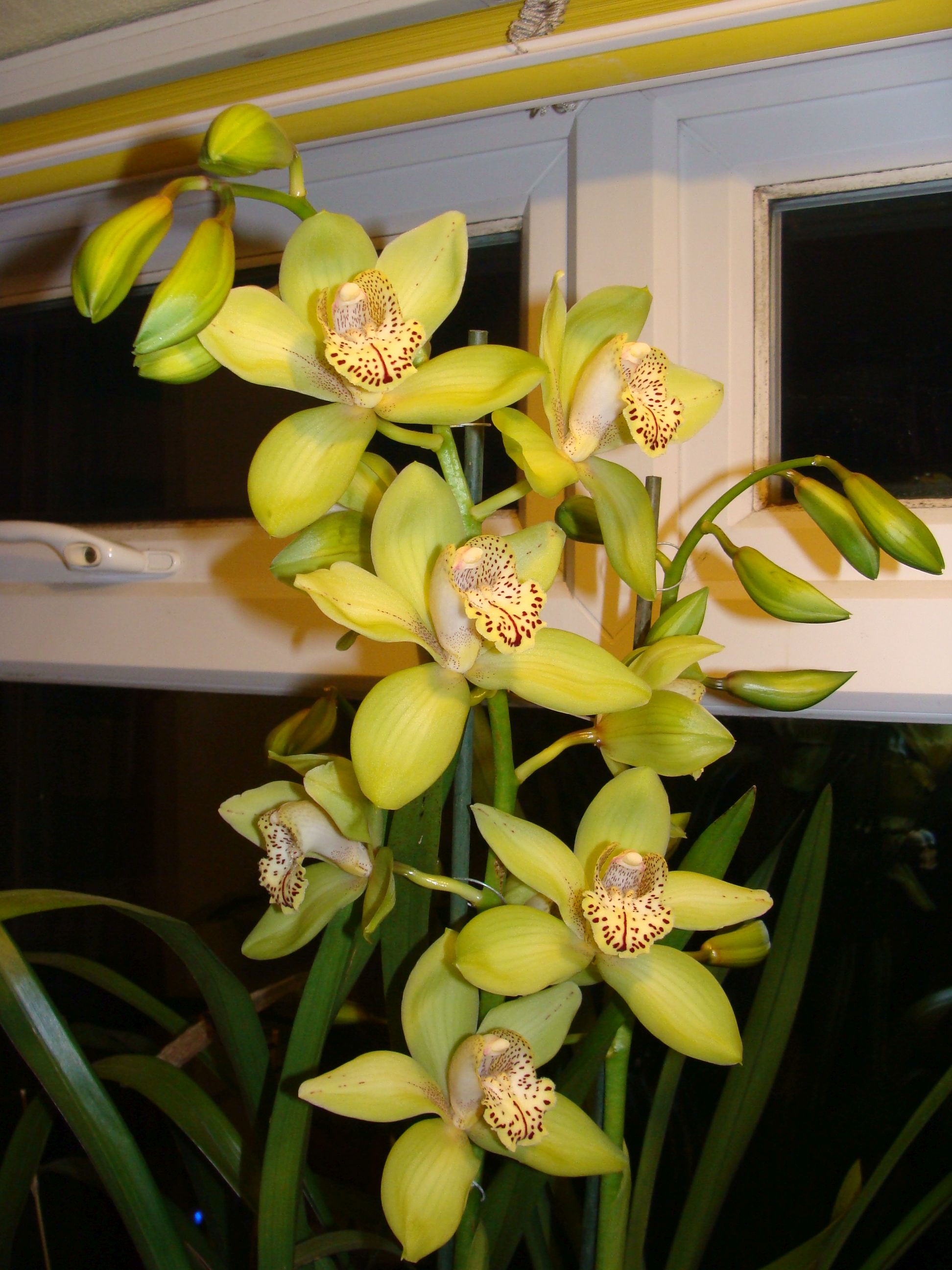
But when it blooms it really puts on a show and is well worth the wait, most of the individual blooms on this first spike being 5.5 inches wide when fully open which is bigger than last year, so the plant is obviously happy and as can be seen it fills up my window sill.
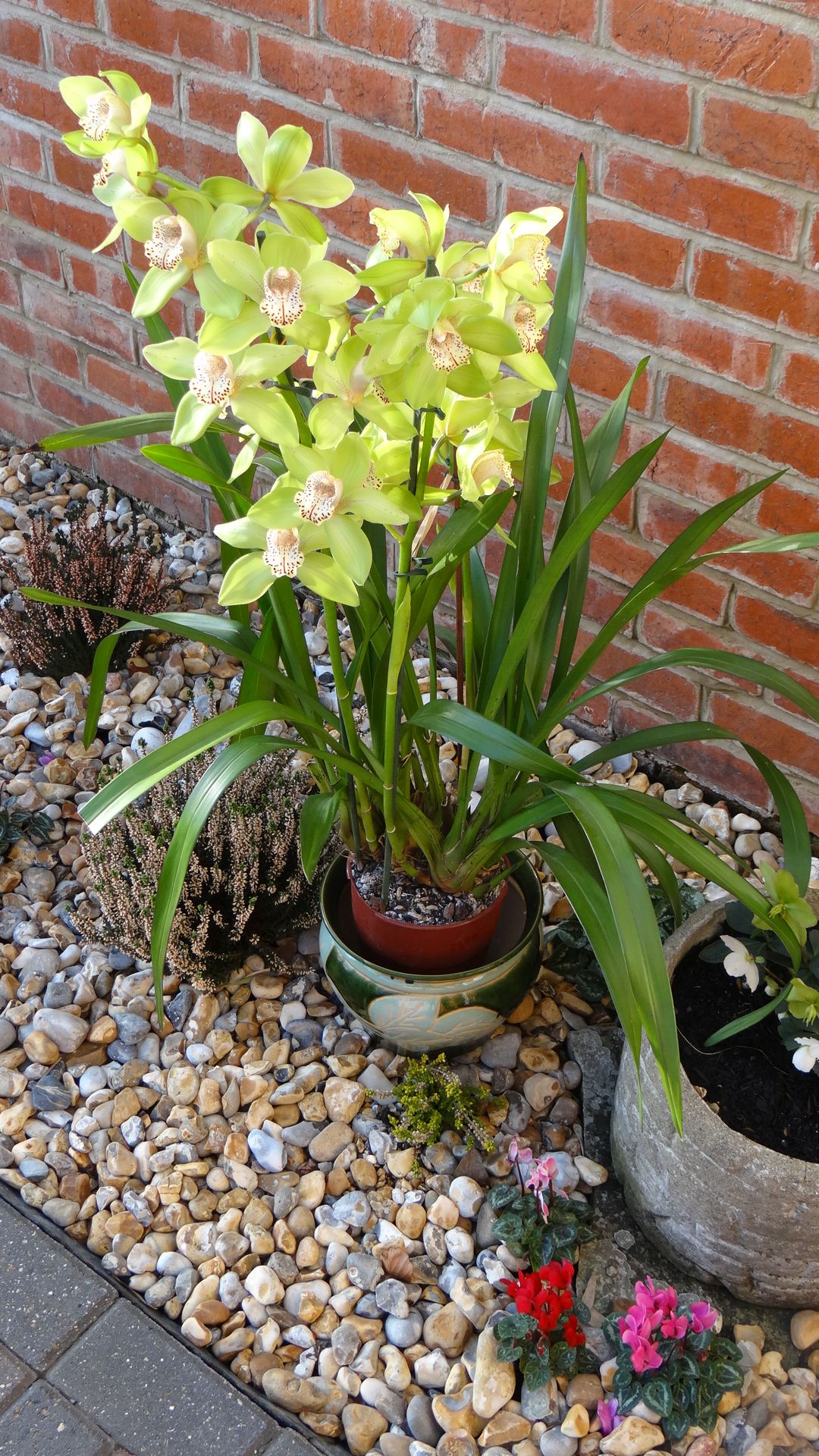 Although using the camera flash makes the petals look yellow in day light they are quite green.
Although using the camera flash makes the petals look yellow in day light they are quite green.Three spikes and 32 large blooms far bigger than they were last year, quite a handful.
Note also that this plant was only taken outside to photograph it is not hardy and MUST remain indoors during the winter months unlike the Cyclamen, Christmas Rose, and heather in the photo which are hardy
I under estimated this orchid this year it started blooming in December just on Christmas time and remained in bloom until the first week in March bearing in mind that this is the second year we have had it is excellent value and is a beautiful plant.
What is also interesting is that as the blooms get older the lip turned pink getting darker as the flower aged, this was attractive in day and artificial light.
Although a beautiful plant and I would love more of them they are very large and so we are unlikely to purchase further Cymbidium Plants.
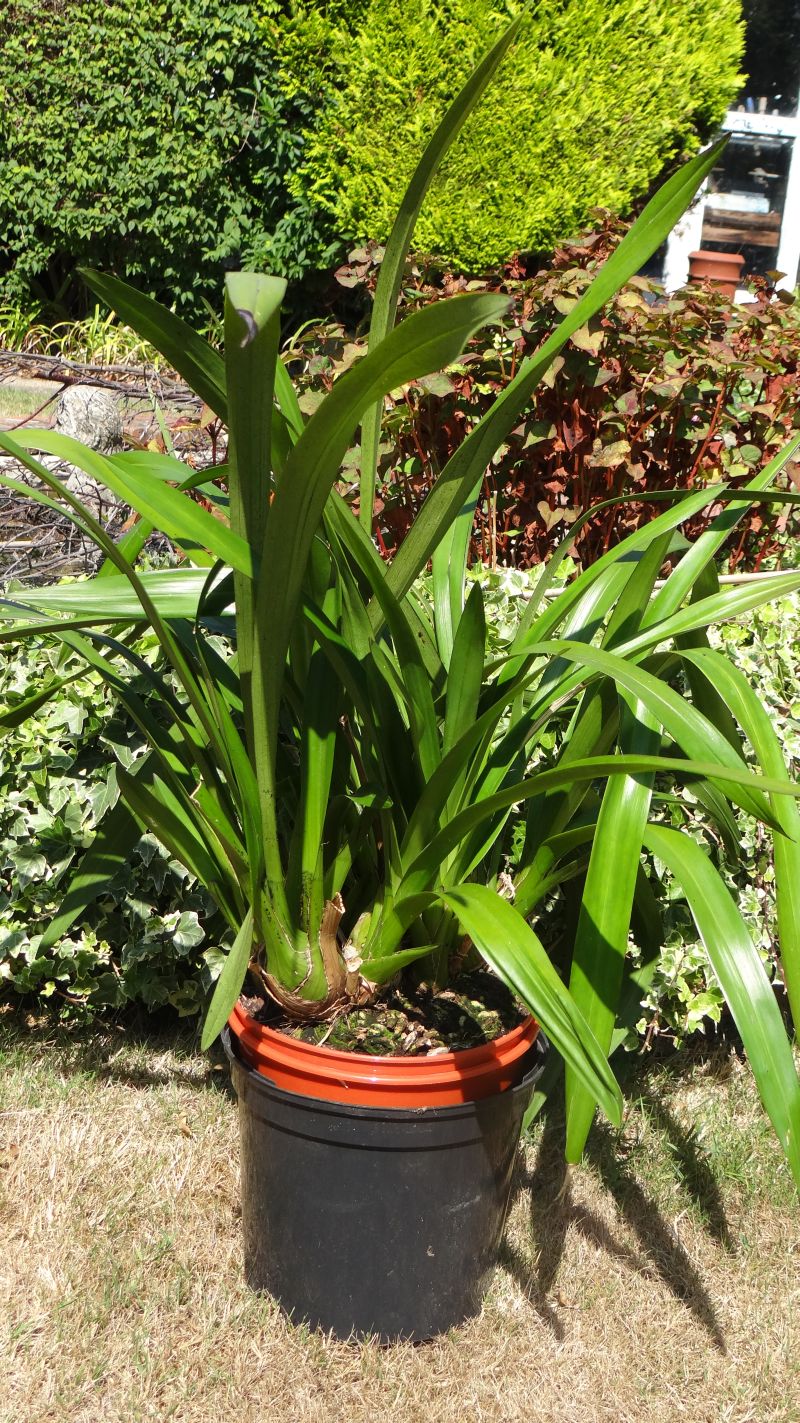
August 2015 and the Cymbidium is outside in the garden normally in a shaded area which does not get direct sun light
I do feed it and keep an eye open for pests such as wood lice that will enter the base of the pot. I also ensure it is watered during dry spells.
About April of this year I re-potted it because the plant was very tight and growth was starting to overhang the edge of the pot I increased from a 9" to a 10" pot centering the plant as much as possible, this was done with the minimum of disturbance to the plant.
I used orchid compost which is mainly bark in the re potting process but took great care not to disturb the root structure within the existing pot which had to cut away as the existing roots were so tight in the pot that it could not be eased from the old pot.
Since that time 4 new main shoots have appeared and it is on these shoots that this years spikes of flowers will appear.
I will photograph the plant again at that time.
I am feeding the plant about once a month with Vitax Orchid growth feed.
This can be purchased off the internet in litre bottles and is far cheaper than purchasing the small amounts at garden centre's
When the spikes start to appear I will feed with Vitax bloom feed.
This change applies to all of the orchid varieties
One of this years new shoots can be seen on the right of the main shoot centre of the picture.
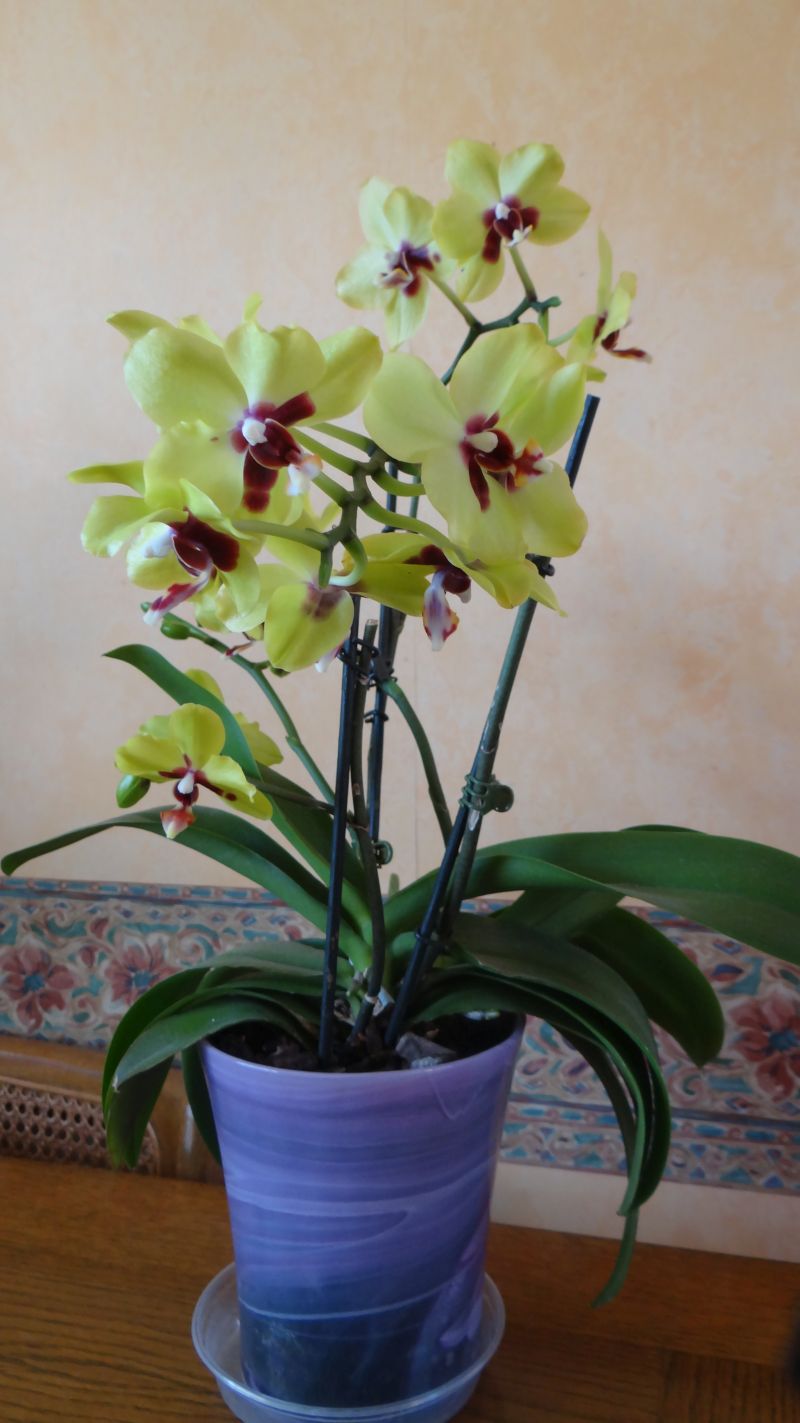
We bought this plant about 1 year ago with two spikes and placed it in the bathroom, from that day it has never been without flowers it just goes on and on, the flowers are slightly smaller than some of the other orchids but it is a lovely plant.
The other thing I have done in the last year is to put all of the Orchids into coloured Glass pots, the pots are 5.5" designed to hold the plastic pot.
When purchased they had no drain hole so would have been unsuitable, as the orchid needs to drain surplus water and not stand in water.
That was soon overcome by using a industrial diamond drill I drilled two small holes in the base of each glass pot.
They like the clear plastic pots allow the light to reach the roots and unlike the plastic pots being heavier do not get knocked over so easily.
We found that as the plants got larger and as the compost dried out they became unbalanced , this has cured the problem and the orchids are doing well, the glass pot simply stands in a plastic saucer and the coloured glass pot enhances the beauty of the orchid.
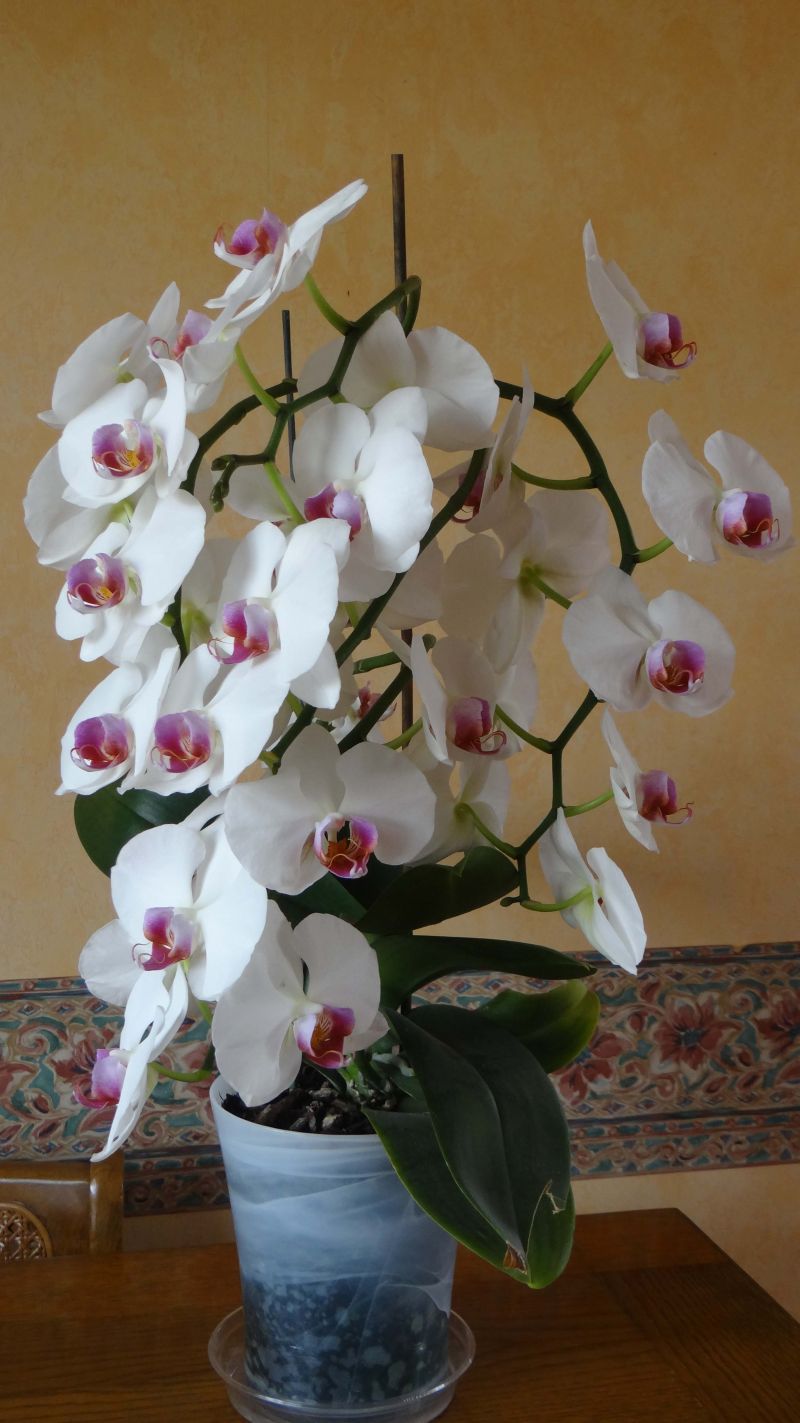
This orchid which is which we have had for many years currently has 38 blooms which are just under 4"wide, again doing very well in it's glass pot.
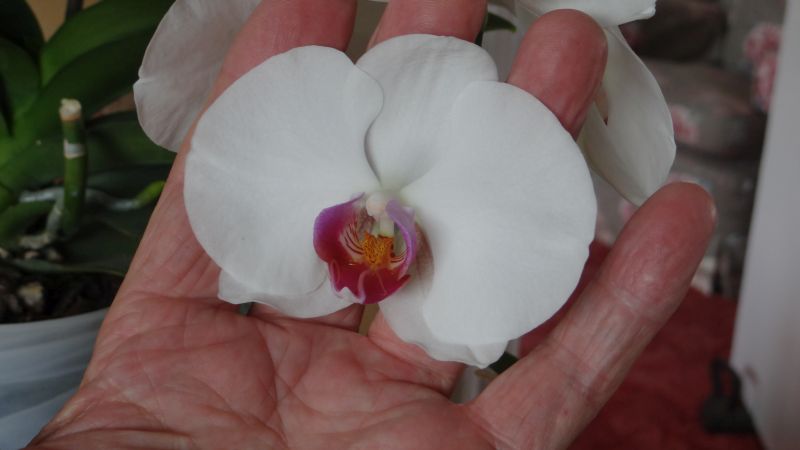

The colour and detail of the flowers is simply beautiful.
Where do the months and years go? It seems and age since I last added any information and photos to this page.
Well the Cymbidium failed to bloom last winter 2015/16 but it is now outdoors for the summer and is already showing great promise for the coming Autumn with several new shoots, which we hope will produce spikes and bloom this year.
The phalaenopsis on the other hand have bloomed most of the time, just feed and watered as required and they go on and on.
We have purchased one or two more plants as at present they are so cheap Wyevale garden centre's of which there are many branches have them reduced at present Ј4.99 the cheapest we have ever seen them some have proved irresistible, in one case a very delicate pink and a pretty variation in the other.

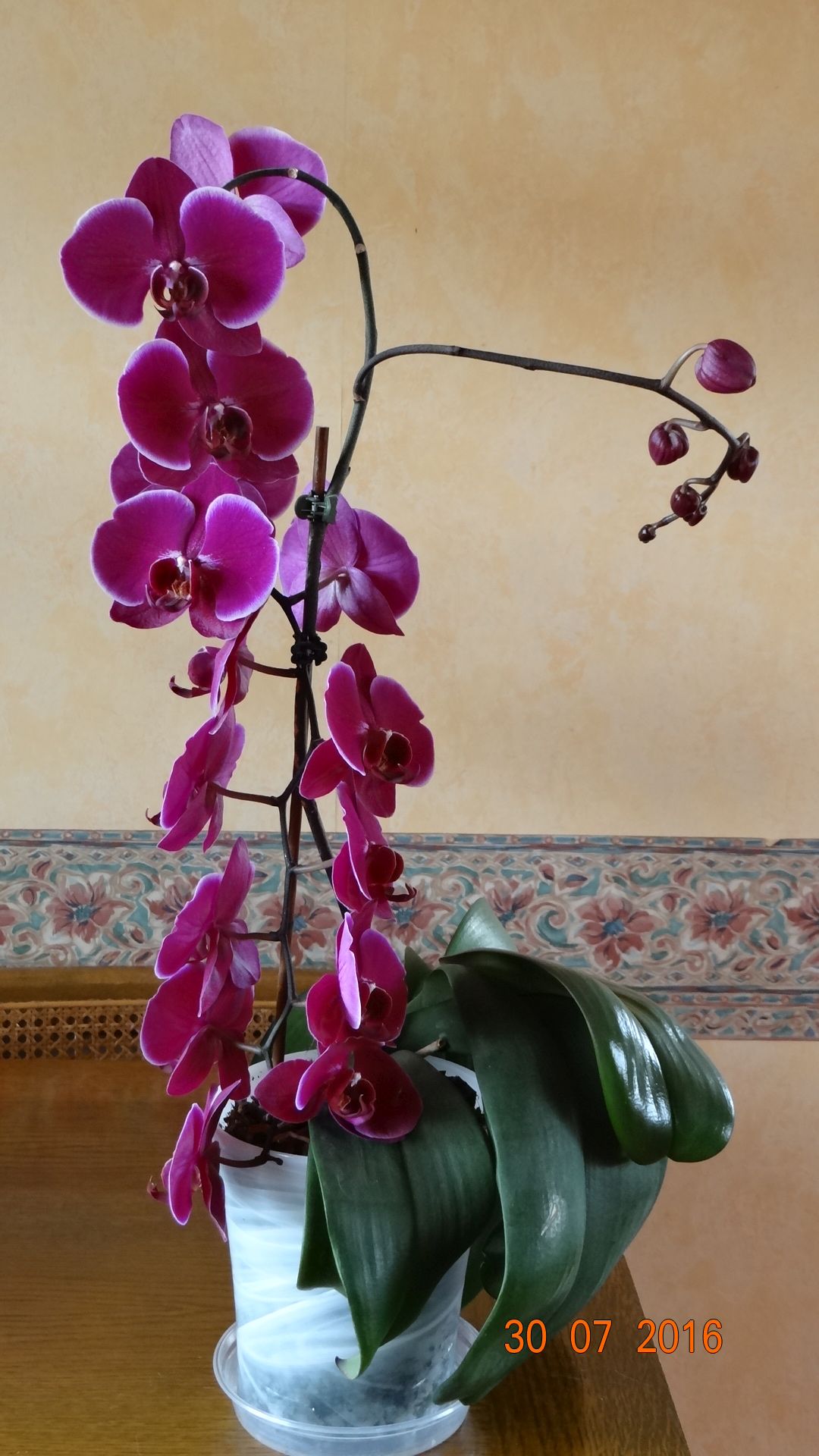 This orchid is just like velvet fifteen large flowers cascading down and its already been in bloom for 5 weeks
This orchid is just like velvet fifteen large flowers cascading down and its already been in bloom for 5 weeks Always looking for the opportunity to display these plants differently, when this plant decided to send up two spikes I made up a hoop and trained the spikes as they grew, the end product is different although one spike has more flowers than the other at present
When buying you Orchid take your time as you can see from the samples here and below there are unnamed types to choose from, for the sake of a word called them branched and non-branched.
The top orchid is a single spike of flowers and although good value for money can be bettered dependent on your preference.
The top orchid has 9 flowers and one bud.
The lower orchid has 30 flowers and sixteen buds yet to open, so in my opinion the branched orchid is by far the better value and will go on to bloom longer.
Remember choose your orchid wisely, look for a healthy plant with as many green healthy buds as possible, that will allow the plant to acclimatise to your home environment as the blooms open and they are less likely to drop /fall.
20/10/2016 Orchid Pests
Those of you who have visited my orchid page will be aware that we have had orchids in the house for well over ten years and many of the plants are original and I posted pictures on this page in August 2016 which clearly shows the plants were healthy and covered in flowers.
Over this long period I have never experienced any problems with pests and we have never had to do anything other than feed and occasionally re-pot.

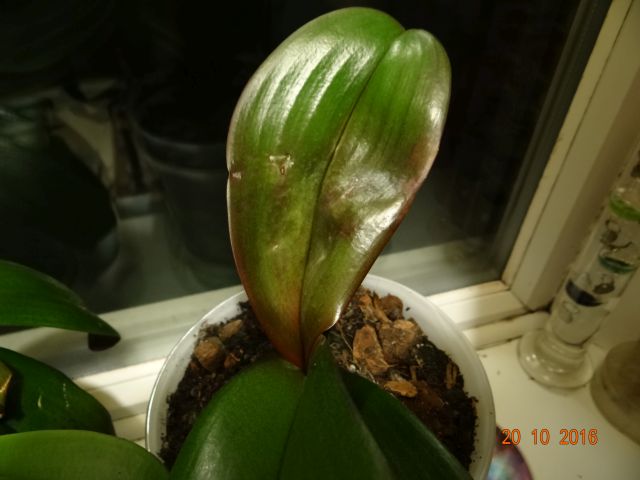
Well all that changed about a month ago when we noticed that some of the flowers were unusually showing signs of stress and the plant stems were being damaged, with signs of mottled stems and discoloration and distortion of the newly forming leaves in the centre of the plants.
The new leaves when closely inspected had small pimples in the surface but nothing could be seen in or on the leaf. as a precaution I removed these leaves from the affected plants.
The section shown in the photo is from a mauve orchid which reflects in the colour of the stem rather than damage although it is clear to see that the stem is damaged and not healthy looking.
Further investigating revealed two if not three different pests:-
1. White fly, a minute fly, although this was very limited in number.
2.Black Thrips, again very few in number mainly on one plant but they were there and again very very small and easily missed, I used a magnifying glass to spot them. The one in the photo on the left is on a standard pin point, the second on the right is trapped/dead in a glue bubble which along with a digital camera has magnified it many times :-
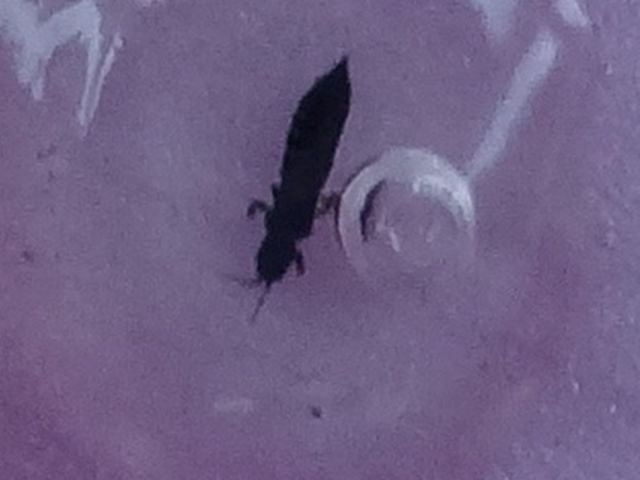

3. Mealy bugs Initially we thought these were limited to one plant and isolated it from the other Orchids we have, however after meticulously inspecting the orchids, flowers and leaves found that the majority of the plants were infected. These take on the appearance of very small white fluffy lumps slightly grey in the centre which is where the bug is hiding, size approx 1/8" located between the leaves, undersides of each leaf and in particular the flower petals and around and under the lip and column (centre of each flower head) of each open flower. I removed these with a fine haired artists paint brush.
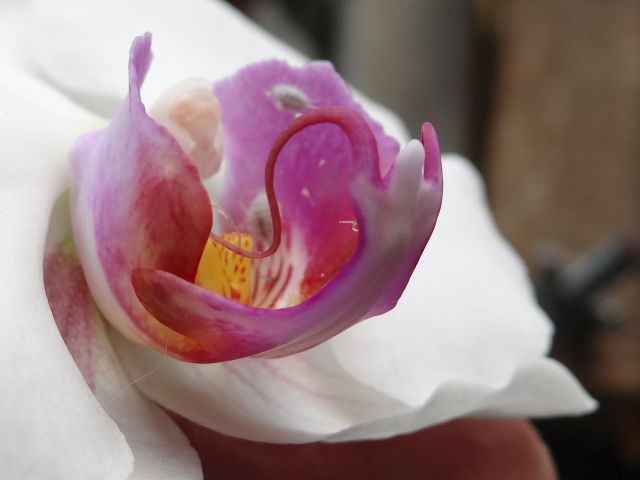
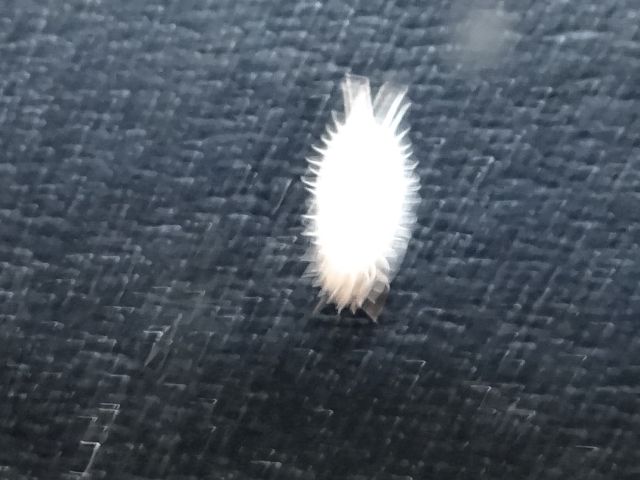

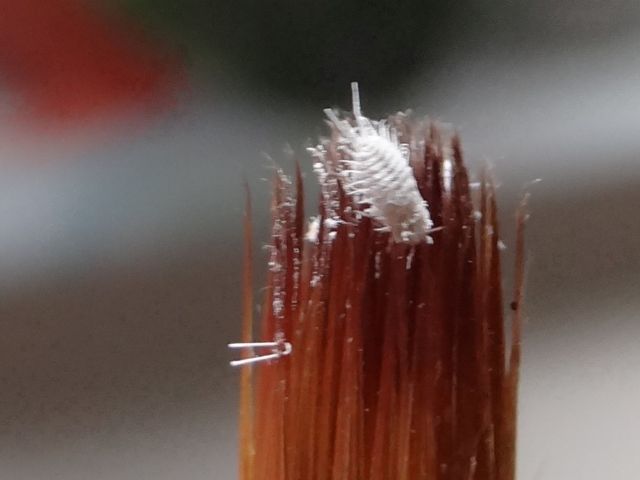
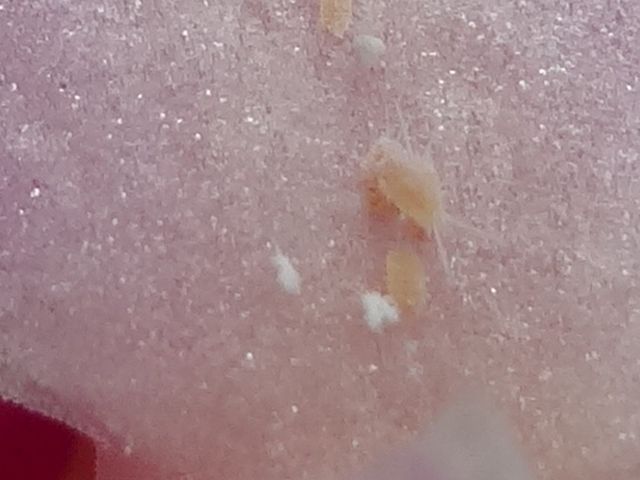
This Photo shows your Mealy Bugs and what I believe to be white fly, however these may have been the white wooly coating of the bugs, either way we do not want either on our plants. The photo above on the left shows the size, the photo on the right shows the mealy Bug without its protective wooly covering which can be seen on the brush bristles, either way it is a nasty little 'Beastie' and if you love your plants,not just orchids then you need to get rid of these pests.
Treatment
I spent a considerable amount of time inspecting each plant outside the house and physically removed the Mealy Bugs with a fine artists paint brush, the few White Fly's were easy to locate and destroy. the Thrips were so few that they likewise were easily deal with.
We then visited the garden centre and purchased a 400 ml aerosol can of 'Provado' Ultimate bug killer which claims to rapidly kill pests fast and also has a systemic action (the chemical mainly ,Thiacloprid is absorbed by the plant through roots, leaves and flowers and when the wee beastie's eat the plant they are poisenedbut of course this does take time, allowing the infestation to become an even bigger problem.
The cost less than one Orchid plant, the product produced by Bayer Garden
This was suitable for dealing with all of the pests detected but do read the instructions before using.
Although you may still be able to purchase this product it is not know produced by Bayer
However my experience was that the Provado Ultimate Bug Killer did not kill the Mealy bugs, Discussions with a representative of Bayer Garden has however revealed that the chemical methiocarb which also doubles as an disperser formulation will stop the bugs eating, dying in the longer term which may explain why these bugs were still alive.
The general consensus was that the Bayer Bug free product may work better with the orchids due to the leaves having a shiny firm surface, the content of that product is a fatty acid which should kill the bugs without them having to eat parts of the plant as with the systemic product. We have yet to try the Bug Free product. However this product would only kill the bugs it comes into contact with so careful and thorough application would be necessary.
Because of the risk of loosing all of the Orchids I firstly removed all but two of the flowering spikes which sadly had to go into the dustbin rather than the compost heap, I then sprayed all the plants ensuring each leaf was sprayed.
Because two of the plants had newly formed spikes of flowers and many buds I left these two but made sure they were closely inspected and that the flowers were washed off with warm water,and then sprayed.
We kept a very close eye on the plants and no further problems were located.
However the two plants on which I left the spikes of flowers were inspected each day and appeared to be clear of any problems but on very close inspection some 10 days later revealed more mealy bugs which you can see on this page, these plants and flowers have all been inspected again and again so I was somewhat dismayed and surprised to say the least to find live Mealy Bugs behind and between the petals and hidden well in the centre of the flowers.
These plants have now been sprayed again and separated from the other spike less plants, albeit one or two of the plants from which the spikes were removed are already starting to show signs of new spike's forming.
It may well be that the two spikes retained will have to be sacrificed to save our beloved orchids only time will tell.
The way in which these pests spread was not a mystery, when the plants are feed and watered they are placed together in a water trough for several hours but do not always get placed back on the same window-sill, in my opinion this has allowed unknowingly contaminated plants to contaminate healthy ones. So keep an eye on all your plants.
So If you have an Orchid collection please be aware they can get pests.
I have my own theory as to where they originally came from.
Taking pity on Orchids placed in what I call the Plant Graveyard at the Garden Centre we visit,(Where unsold plants of all types are stored and sold at very much reduced prices) I had purchased a couple of healthy looking orchids's that were simply asking for a good watering and feed, these along with other plants were well away from the normal retail sales.
I have a suspicion that I got more than just plants wanting a good feed and watering and the pests came with them Free of charge! lesson learned.
Take great care when buying any your plants and reject any plants with which you are no happy.
I hope you find this information useful, and that your plants remain healthy.
I will update this information as time goes on. Lofty
21/10/16
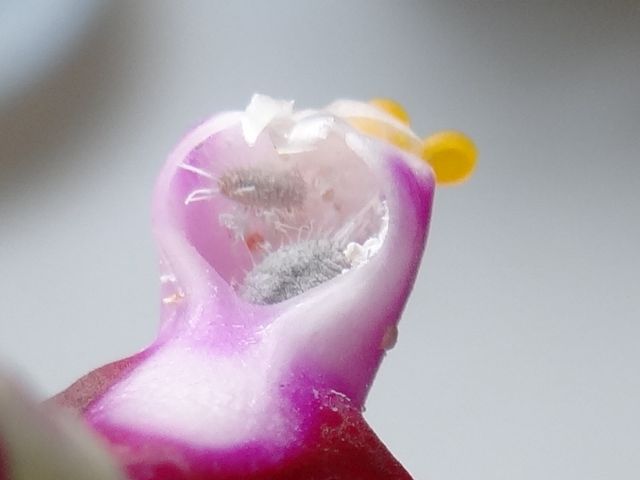
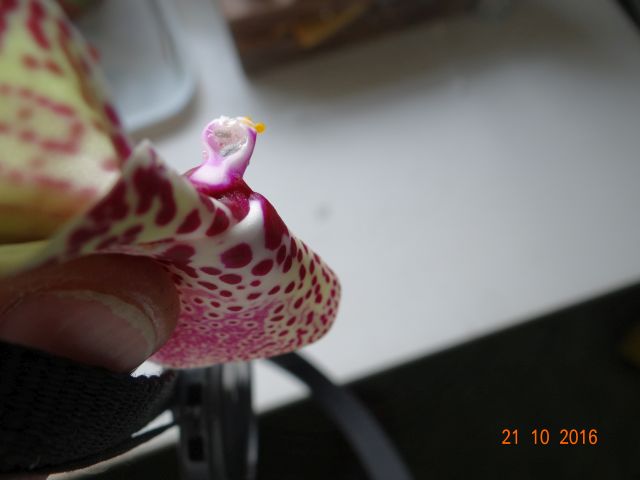
The two plants remaining with flowering spikes have been closely inspected again today and to my disgust I still found a family of mealy Bugs housed in the Anther cap, of one of the flowers (the small cavity where the two yellow un-germinated seeds are housed in the centre of the flower. There is every possibility that some of these have hatched since the original application of Provado, although by their size not in every case. ) The spike on this plant has now been destroyed and the plant re-potted. At present the second plant appears to be clean but I will be keeping a very keen eye on the whole plant.
13th November 2016 follow up to mealy bug problem
Well I think we have now successfully illuminated the mealy bugs that invaded our orchids, We did have to destroy one of the remaining two spikes of flowers because of the number of mealy bugs located in the flowers, that done one spike which was mainly all buds has survived and is free of the pests.
It appears the best way to deal with these wee beastie's is by constantly looking/inspecting each plant and removing any pests seen with a cotton bud dipped in either paraffin or methylated spirit. this does involve being vigilant after the event. We will certainly be keeping an eye open for them in the future.
This process needs to continue because the eggs laid by the bugs hatch several days after the first pests are destroyed.
 Where plants are severally affected they can be sprayed with Bayer Garden,'BUG FREE' this is a contact insecticide which contains fatty acid as well as other chemicals and kills the bugs on contact, so careful spraying is necessary ensuring you get to all parts of the plant and flowers.
Where plants are severally affected they can be sprayed with Bayer Garden,'BUG FREE' this is a contact insecticide which contains fatty acid as well as other chemicals and kills the bugs on contact, so careful spraying is necessary ensuring you get to all parts of the plant and flowers.
Although I have purchased this product I have not used it as we are now free of the bugs but nothing is lost as the spray can be used on other outdoor plants shrubs and trees infested with pests.
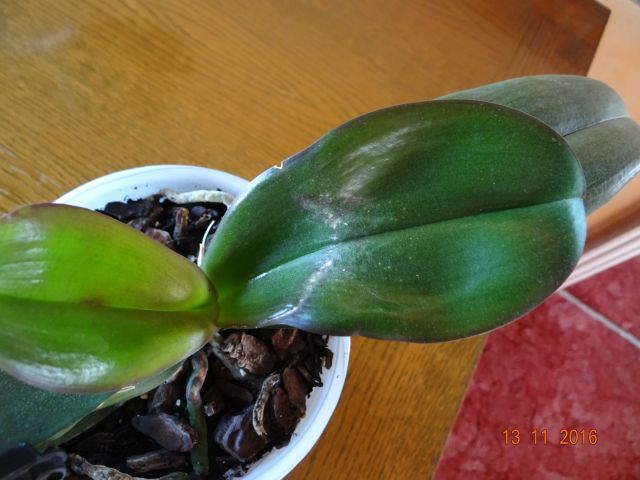 In our particular situation the best line of attack was to destroy the spikes of flowers where most of the bugs were found, if you only have a few plants spraying and then removing the bugs by hand may be the best method.
In our particular situation the best line of attack was to destroy the spikes of flowers where most of the bugs were found, if you only have a few plants spraying and then removing the bugs by hand may be the best method.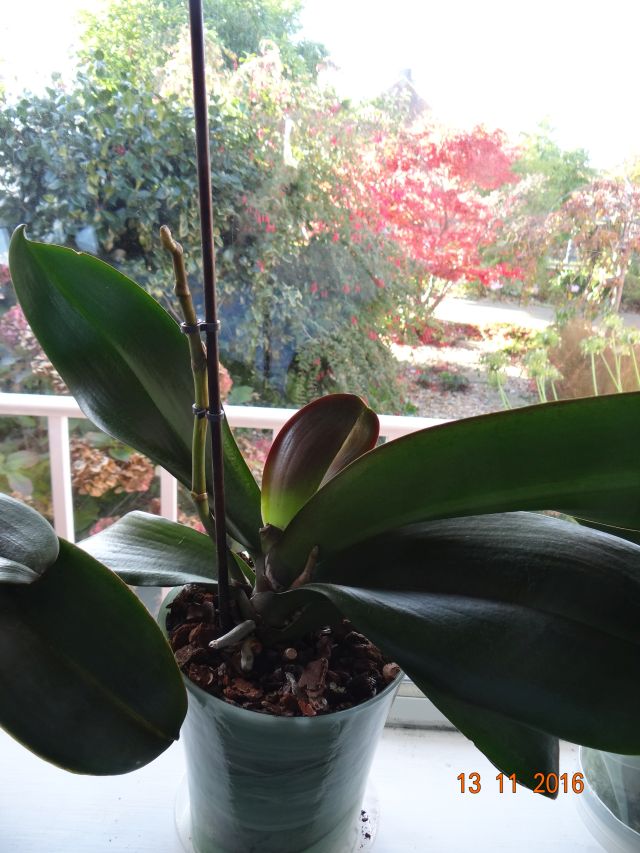 Although we lost all the spikes of flowers bar one on the seventeen Phalaenopsis we have, eight of the plants are already showing new spikes developing, some of the leaves (see above) still show signs of damage they are not unsightly, just scarred so have been left they will grow out in time.
Although we lost all the spikes of flowers bar one on the seventeen Phalaenopsis we have, eight of the plants are already showing new spikes developing, some of the leaves (see above) still show signs of damage they are not unsightly, just scarred so have been left they will grow out in time.18.11.16 Update
I cannot over stress enough the need to remain vigilant once you have destroyed the mealy bugs on your orchids. Today my wife noticed just the smallest amount of white fibre like material on the edge of one of the orchid leaves, the flowering spike had been removed earlier.

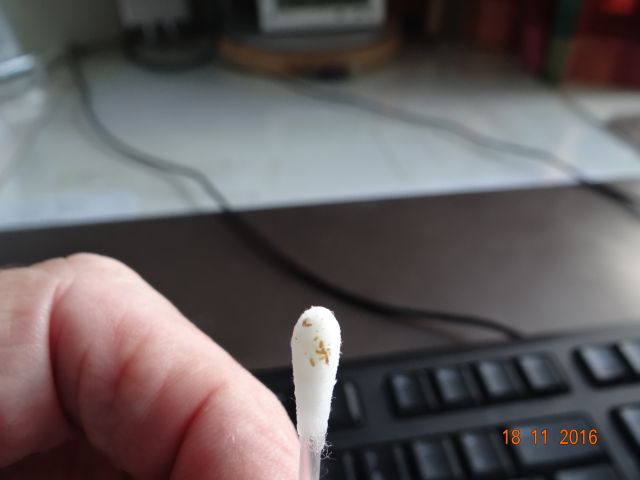 I wiped this off with a cotton bud dipped in paraffin, I then photographed the cotton bud that you see on the right. They could not be seen with the naked eye.
I wiped this off with a cotton bud dipped in paraffin, I then photographed the cotton bud that you see on the right. They could not be seen with the naked eye.I am confident this was a collection of baby mealy bugs which would have infested the orchid at a later date given the chance.
4th December 2016 update
We have at last got rid of the mealy bug infestation, it has be a long process with most bugs being detected and destroyed by detailed inspection of the plants almost daily. Even when we thought they had gone at least two more mature bugs were found.
I'm also please to say that 14 of the plants on which the flowering spikes had to be removed and destroyed are sending up new spikes, so by early New Year 2017 we should have a bungalow of flowering orchids again.
Update 13.1.17
Well here we are in 2017, I am pleased to say that we are now clear of the mealy bug saga and all of the plants have servived. 15 of the plants now have spikes of flowers forming and the first flower has opened today so we are now looking forward a blooming spring with lots of colour.
I am a little disappointed because our Cymbidium plant is not showing any signs of flower spikes, although it is not too late for it do so
Certainly the Phalaenopsis orchid is better value and easier to look after then the Cymbidium.
I will keep you informed.
Update 2.2.2017
Well I spoke too soon , we have located and destroyed about 4 bugs since I said they had gone, we still inspect the plants almost daily and so are able to spot these beastie's before the infest the plants again, this one a mature mealy bug was only discovered and destroyed yesterday. It is of course magnified many many times, the actual insect only being about the size of two pin heads.
Seen up close as in this photo and you could be forgiven for thinking it was from another World.
So if you are unfortunate enough to get these bugs on your Orchids remain vigilant for an extended period after they appear to have been eradicated, it appears the eggs remain and hatch long after the their first discovery.
The good news is we have orchids back in bloom and the majority have new spikes for the future.
Update 03.03.2017
Back in business, As can be seen most of the orchids are back in bloom after a 4 month gap without flowers.
we have found the mealy bugs one of the most difficult pests to deal with, they appearing many times after we thought we had eradicated them. Even after we had conviced ourselves that we Had won the battle we still found one adult bug .
We are still inspecting the plants very regularly to see if there any signs of there re appearance as off today we are clear but will keep the inspection of each plant up for some months to come.
As can be seen the hard work paid off and we now have a spandid array of flowers again in many different colours with several plants yet to bloom. All is clear at present with no more signs of mealy bugs or other pests.
Return to index